And I saw a new heaven and a new earth, for the first heaven and the first earth were passed away, and there was no more sea.
Revelations Chapter 21, Verse 1 – King James Bible
I’ll leave you a moment to contemplate the irony that the above quote is being used to introduce Card XXI. If you have read last week’s article, you no doubt picked up on my fascination with the last book in the Christian Bible. I am not Christian by any means, but I was raised in a community that was tacitly Christian, and even the non-church going folk were believers. It was also an insular community which did not place a great deal of value on scholarly pursuits, so outside of an old tattered copy of Grimm’s Fairy Tales, some Childcraft Encyclopedias my parents bought on payments, and a handful of comic books, the Bible was the only available reading material for much of my youth.
Revelations was also the most magical and mystical of the books, with things like dragons and monsters and beasts full of eyes with six wings and horses with peoples heads, scorpion’s tails, and lion’s teeth. Certain more interesting for a young person with a penchant for weird than all that begatting stuff.
And as noted in last week’s article, the World is not what it started out to be.
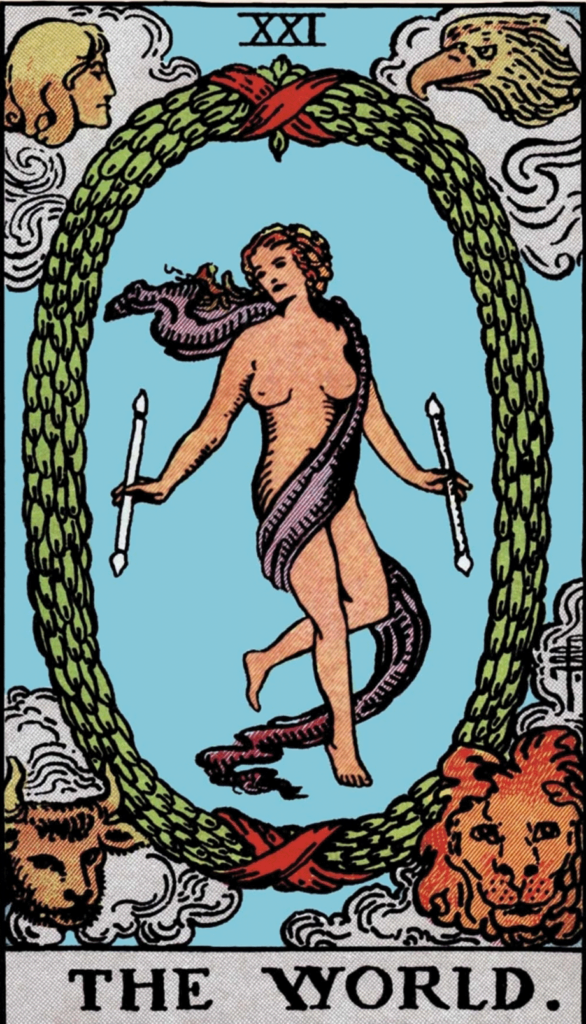
The World is represented as a nude woman, with a sash winding around her. She holds a wand or scepter or baton in either hand. She appears inside an oval or ellipse that may be made of laurel leaves, like the traditional Roman crown of honor and victory. In the corners of the card, inside clouds, are the heads of a person, and eagle, a bull, and a lion. The background of the card is blue. There is no visible land or water.
Typically this card is seen as attainment, completion, or totality. Lately it has also come to be associated with Mother Nature, or Mother Earth, as the New Age, pagan, witchcraft and occult communities become more aware and concerned with the conditions on the planet, and the impact our tenancy is having on it. Yet neither of these associations is in keeping with the original images to be found on the earlier versions of these cards.
In the Visconti Sforza deck, we find this card represented by two cherubs or children (such as the missing twins from the Marseilles version of the Sun card) who hold up an orb containing a castle. This castle represents the City of Holy Jerusalem, which is said in verse 2 of Revelation 21 to descend from out of heaven to signal the new Utopian world following the trials of the End Times. Holy Jerusalem, and it’s measurements, worked out by mystics and bible scholars in the early Christian centuries, serves as the basis for the Gothic cathedral, and the numerous mystic, magical, and masonic rituals and traditions associated with those buildings. It’s also where we get the gold-paved streets and gates of pearl that are frequently assigned to heaven itself by modern evangelicals.
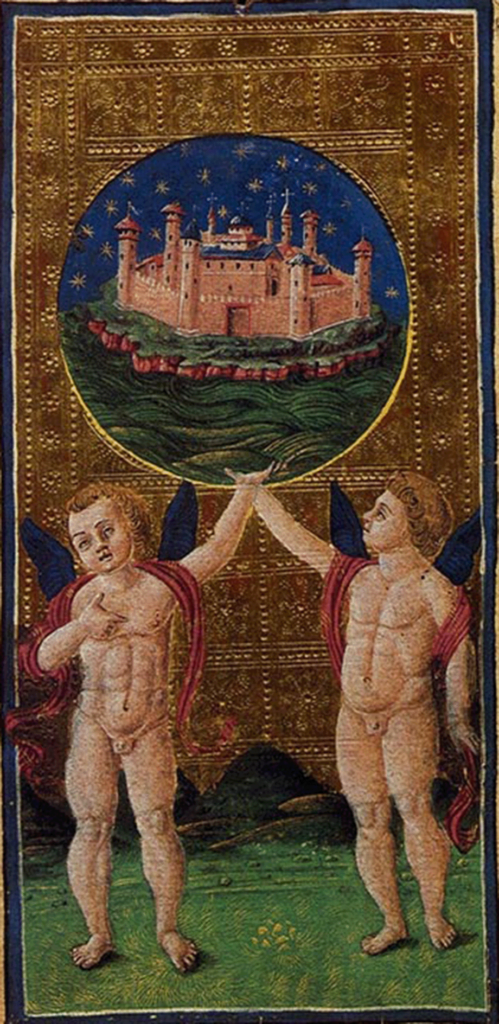
As a sequel to the Judgement Card this makes far more sense than a more or less pagan lady in the altogether. This is especially so if Huson’s theories about some of the Tarot imagery coming from the early Christian mystery plays. These were designed to teach biblical truth to a largely illiterate population. As such, many of them were made much more elaborate so as to be engaging and memorable. Even then, the movie was often much flashier than the book.
Huson also relates a version of the World where it is not our Gaia-esque figure here, but Christ himself. In fact, the image he offers I recall from my art history class as Christ Pantocrator, which is “Christ, King of the World”. This also would seem to be a more apt follower to the apocalyptic Judgement card.
Pantocrator is very frequently shown inside a mandorla, which is the official term for the elliptical or oval shape represented in RWS as a laurel wreath. The mandorla is an artistic convention, used to express a sacred or otherworldly space. It is frequently occupied by Christ, or the Mother Mary, or God Almighty, and often includes a company of angels, holy personages, and other important people, like the heads of the local church, nobles and chieftains, and particularly people who paid the painter.
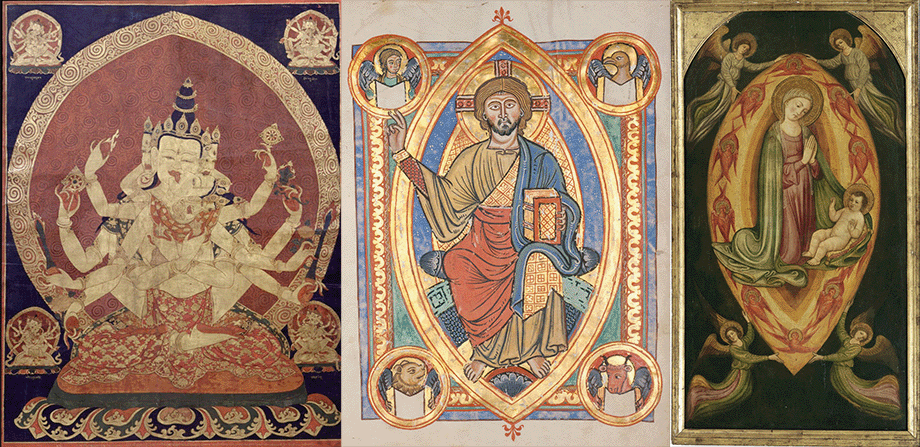
The center piece is Christ Pantocrator, from a Byzantine gospel book. You’ll no doubt recognize the sacred animals that appear in the Wheel and the World cards. Here they represent the four authors of the Gospel, but their origin is in the Old Testament, and in Revelations. The attribution of this specific meaning is part of the writing of the early church fathers, who struggled with a need to define what these strange images were. Later occultists would give them astrological attachments, or perhaps they rediscovered those that had been purloined by the church.
In any case the four beings of the corners are common to both the Asia image on the left, and that of the Virgin on the right. In the case of the Virgin and Child the mandorla itself is made of circling angelic beings identified as either cherubim or seraphim. These also stem from the vision of Ezekiel.
Regardless of it’s origins the mandorla represents a gap between our cosmos and the divine one. It is worth considering this when looking upon the visage of the World in the final Tarot trump.
Mandorlas seem to make their way into religious art from icons found in the Eastern Church, which were inspired by Byzantine mosaics. But we can also find mandorlas in the arts of Arabia, India, and China, so it is entirely possible they made their way to Europe on the Silk Road from Asia roots.
They might best be described a visual depiction of a rift in space. The inference is universally that we are seeing something not in this world.
Our idea of the “aura” may stem from these depictions. They are sometimes multi-hued or rainbow colored. That this spectral effect is the product of the spatial separation versus and emanation from the beings inside it is not certain. Persons having such encounters even today are not clear on the experience, but the descriptions seem to be close to this phenomenon.
This shouldn’t be confused with the idea of the mandala, although, as another mystical visualization, there is some common ground. The purpose of the mandala is to serve as an aid to meditation and understanding by depicting a spiritual realm as a sacred space. The space is typically centered on the deity or deities to whom the mandala is dedicated. Moving outward from that center we may find subordinate deities, associated deities, avatars, aspects, even depictions of demons and enemy beings trampled or defeated. The space is frequently divided into quarters, and there are things like gates and guard houses, populated by protective spirits, the whole making up a personal microcosm for the deity that is his or her place of power. In the making of the mandala the artist is meditating on the various principles involved in each depiction, and when finished, if permanent, then others can make this same mystical journey.
Let’s consider the more elaborate of the Christian mandorlas in a similar vein, with depictions of the various orders of angels, then a ring of saints and martyrs, then important personages perhaps living at the time of the creation of the piece. There are striking similarities, and while the idea of meditation is very different in East and West, it may be said that the Christian image does evoke a similar inward journey.
I’ll digress a bit further here and look at the similarity between these art objects and the sacred sand paintings of the American Southwest indigenous peoples. These share much in common with the mandala. They use a very symbolic language to represent gods and demi-gods and sacred narrative. Like some the Buddhist mandalas, these are also meant to be temporary constructions, destroyed once the magic is made, to prevent contamination by malevolent spirits.
We might further include the various Meso-American “calendar wheels” in this discussion, though their abstraction makes them a bit less directly so. Yet they do express a means of defining the cosmos, and that is in keeping with the ideology in the World card. And it underscores the importance we ought to ascribe to it, whether we come to it from a neo-pagan ecological perspective or an antique Judeo-Christian one.
Those four critters in the corners we’ve seen before. They are in the corners of the Wheel Of Fortune. As noted in the article for that card, they come from biblical sources, firstly the “living beings” in Ezekiel’s vision. In John’s Revelation they are referred to as the four beasts that surround the heavenly throne (though he gives them a lot more eyes). This is further testament to their origin as surrounding an image of a male Christ rather than a female Gaia.
In church dogma they are representative of the authors of the Four Gospels. But they are also astrologically Aquarius (human), Scorpio (eagle), Taurus (bull) and Leo (lion). Thus they are also then equal to Air, Water, Earth, and Fire, and subsequently to the suits of Swords, Cups, Pentacles, and Wands. They can also be seen as the Four Winds, Four Directions, Four Archangels, etc. depending on which system you want to employ them in. Very versatile these critters.
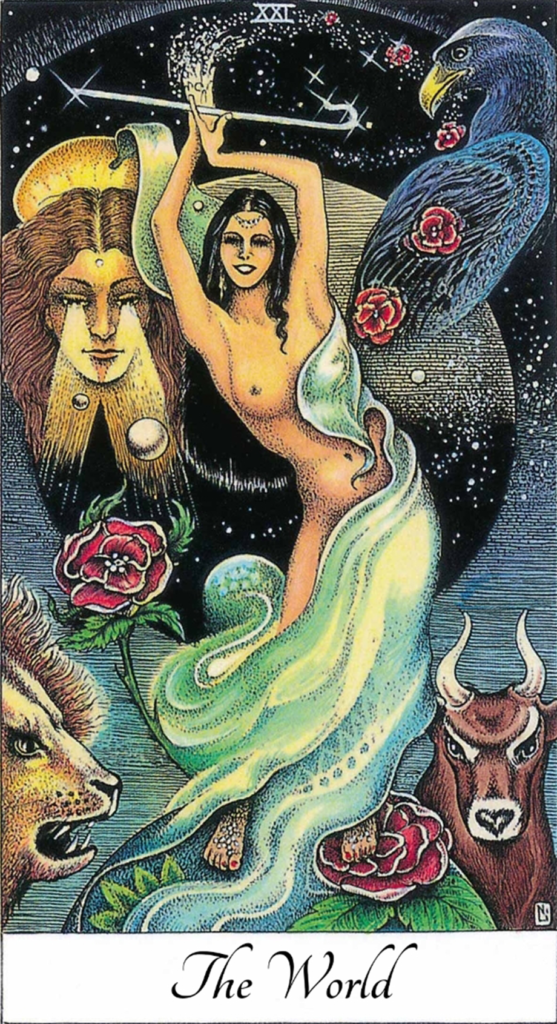
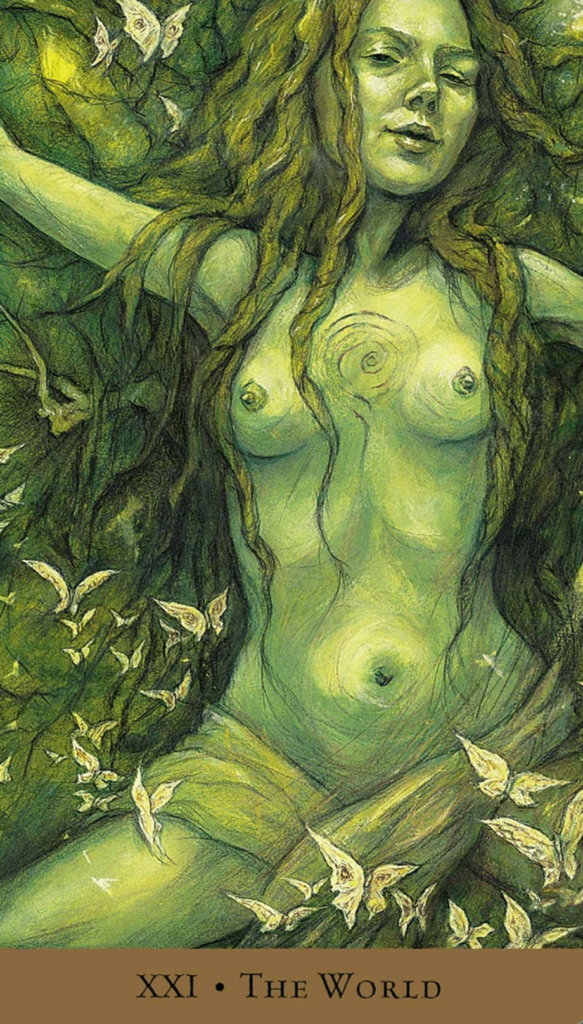
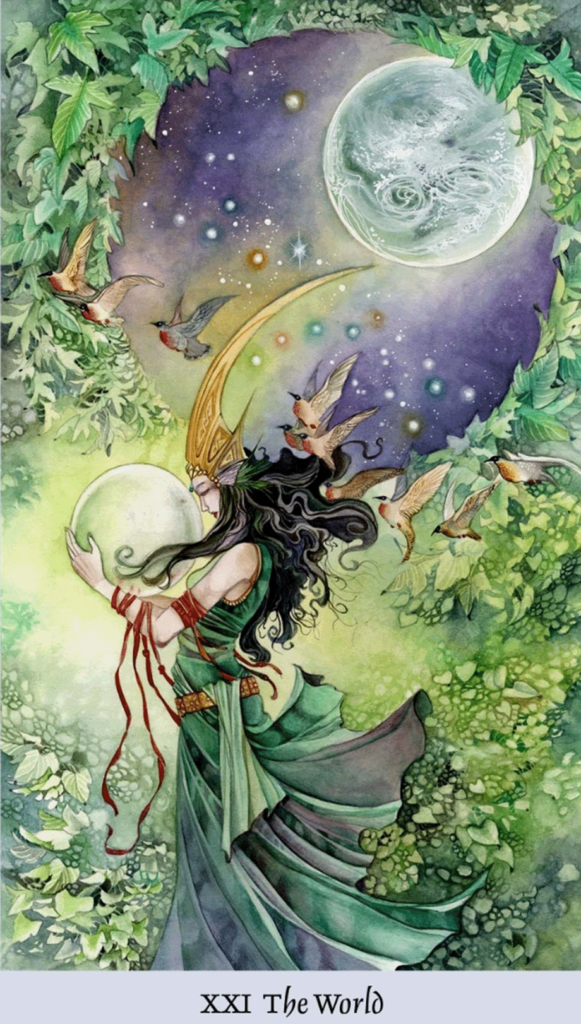
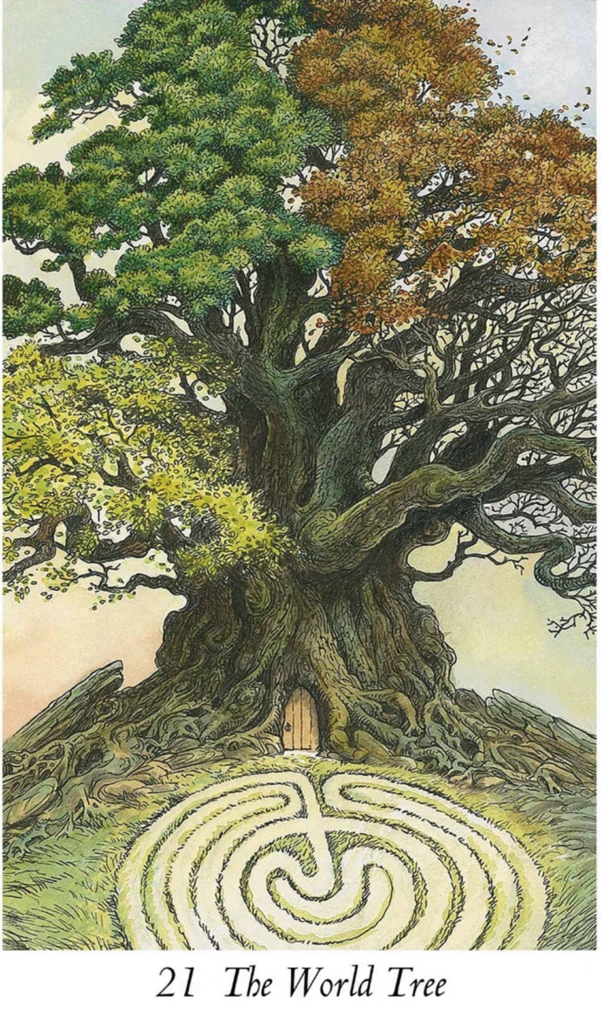
With Tarot, one is always walking a balance between the work of the artist and interpreter, and what the actual images on the cards bring to mind. This quasi-intuitive approach provides for an infinite number of narratives when we lay the cards out. But we must remember how much our reactions, conscious or otherwise, may color that narrative. It is the fine line between, what are the cards telling us, and what are we telling the cards.
Let’s drop back and look at them elementally though. As in the Four Elements of Air, Water, Earth, and Fire. In the center then, our figure of “the World” becomes by extension Quintessence – The Fifth Element. This element is styled as “Spirit” and this then tells us that the World, inside its sacred space is Spirit. It is not the mundane. It is not the physical, but it is that which transcends the physical. It is infinite, and eternal. It is everything and the nothing by which everything comes into existence. It is time and it is timeless.
This idea is hardly diminished if we look backward to the depiction of this as a Utopian paradise that comes after “the first heaven and the first earth were passed away” or even if it comes to us as a patriarchal and somewhat authoritarian depiction of the “King of the World”. We may still find here Ma’at, that cosmic truth and order that is nature itself.
As I noted in the discussion of the visionary portions of Revelations, the descriptions of things speak of a person’s struggling to share a deeply changed perception of the nature of reality with someone who has not had that experience, using the limitations of our linguistic structure. And further these may be couched in the concepts of the time they were written. Yet within them is a kind of ecstasy that they deeply want to share, but are frustrated in doing so. We are left with the imperfect version, with wild symbols, and tyrannical avatars, disturbingly violent depictions, and in some cases overt pornography. When these broken shadows are encountered by the less enlightened, misinterpretation is inevitable, and fear and hatred may be the result. It is the lack of the complete understanding of the experience, of the true nature of the cosmos we inhabit, of it’s existence beyond the physical corporeal and provable, that engenders otherness, and from otherness stems iniquity, envy, and apprehension.
The physical world, with it’s greed and privation, it’s war, famine, pestilence, and death, are the result of its own incomplete state. Where the spirit prevails, peace and harmony are possible. Where a greater vision is encompassed, happiness naturally ensues. Yet the limitation of the physical, the dependence upon finite resources, on structure and ego, continue to create such otherness, and disturb such natural order.
The physicists call this entropy. It is the tendency of the universe to fall apart. In a physical world, more energy is required to keep order. Chaos is easier. The End of Time is marked by everything becoming so broken and so far apart that there is simply not enough energy left to put it back together into any sort of ordered form. Like Humpty Dumpty, our universe has taken a great fall.
Yet physics also says energy can neither be created or destroyed, only moved from point to point. So in that end, at the Great Dark Silence that awaits, there must still be that same energy that was there.
That energy is the Quintessence. It is the Spirit. The actual living thing that brought about the Cosmos in order to know itself. And that cannot be destroyed. The World is, and was, and will be.
Next week I will have one more article in respect to the Major Arcana. I have enjoyed this exploration. I must admit it has led me down some rabbit holes that even I did not expect. I hope they were not too obscure. And if they were, well, we occultists are by definition in the obscurity busy.
Please join me next time.

